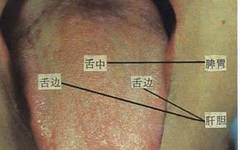

Tongue Diagnosis: Organ Correspondence Chart
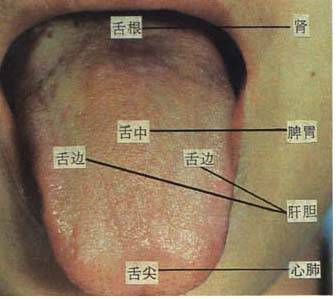
According to the “Neijing” (Inner Canon), different areas of the tongue can reflect pathological changes in various organs, which has certain clinical reference significance. The tip of the tongue corresponds to the upper jiao (heart and lungs); the middle part corresponds to the middle jiao (spleen and stomach); the root corresponds to the lower jiao (kidneys); the sides correspond to the liver and gallbladder.
The “Shanghan Zhi Zhang · Cha She Bian Zheng Fa” also states that “the tip of the tongue belongs to the upper jiao, the middle part belongs to the middle jiao, and the root belongs to the lower jiao”.
Tongue Color Section
1. Normal Tongue
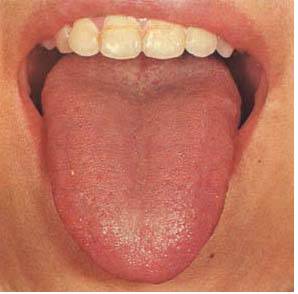
The characteristics of a normal tongue are: a light red color, moist texture, moderate size, and flexibility; the tongue coating is even, thin, white, and moist, referred to as “light red tongue, thin white coating“.
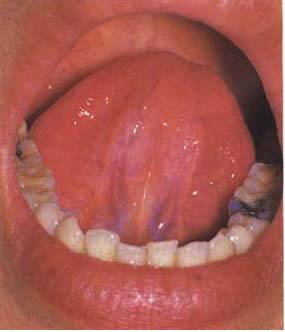
The normal sublingual veins are only faintly visible, appearing as purple-red lines, and should not be swollen. Most are single branches, with the largest diameter not exceeding 2.7mm, and the length generally does not exceed 3/5 of the line connecting the tip of the tongue to the sublingual tubercle.
2. Pale White Tongue
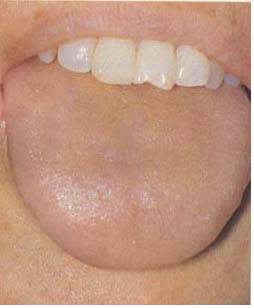
A pale white tongue is often seen in cases of yang deficiency with excess cold, and qi deficiency with blood deficiency. This tongue is pale white with a thin white and moist coating, indicating qi and blood deficiency.
3. Withered White Tongue
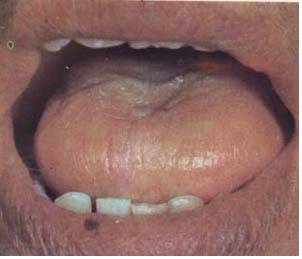
The tongue color and the gums and lips lack blood color, referred to as “withered white”. This tongue appears withered and dry, unable to extend, indicating decline of vital energy, critical condition.
4. Red Tongue
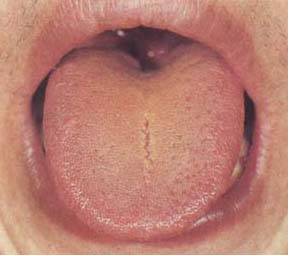
A red tongue is seen in cases of external heat or yin deficiency with excess fire. This tongue is red, with a thin yellow coating, and the tongue texture is rough, indicating excess heat in the qi level.
5. Red Tip of the Tongue

A red tip of the tongue is often seen in cases of heart fire rising, indicating heat in the upper jiao. This tongue has a red tip with the rest being light red and moist, indicating excess heat in the upper jiao.
6. Deep Red Tongue (1)

A deep red tongue, referred to as “deep red tongue”, indicates excess heat. In cases of external pathogens, it signifies heat entering the nutrient level; in internal injuries with yin deficiency and excess fire, it is also commonly seen. This tongue is deep red and dark, with leaf-like shallow cracks on the surface and little coating, indicating excess heat, qi and blood stagnation, and damage to the righteous qi.
7. Deep Red Tongue (2)

This image is from a patient with chronic gastric fire, showing a deep red tongue, dry with no coating, and shallow cracks on the surface, indicating internal heat blazing, gastric yin depleted, and significant damage to gastric qi.
8. Deep Red Tongue (3)

A deep red tongue with little coating and many red spots (indicating bacterial congestion) on the anterior part, indicating excess heat, damage to both qi and yin.
9. Cyanotic Purple Tongue

A cyanotic purple tongue is caused by poor circulation of qi and blood. This image shows a patient with chronic bronchitis and secondary infection, pulmonary emphysema, and heart failure, with a dark purple tongue and white greasy coating, indicating phlegm and fluid retention, lung and kidney qi deficiency, and blood stasis.
10. Pale Purple Tongue

A pale purple tongue is often seen in cases of yang deficiency with excess yin. This image shows a patient with pulmonary heart disease, with a pale purple tongue and thin white moist coating, indicating insufficient yang qi, poor blood circulation.
11. Pale Purple Stagnation Tongue

This image shows a patient with menstrual irregularities (dysmenorrhea), with a pale purple tongue and many purple spots, and a thin white moist coating, indicating insufficient yang qi, cold congealing and blood stasis.
12. Purple Red Tongue

This image shows a patient with a constitution of yin deficiency, with a red tongue and little coating, due to lung infection and heart failure, with a purple-red tongue, accompanied by fever and cough, indicating internal heat, qi and blood stagnation.
13. Purple Red Tongue

A purple-red tongue with a prickly tip, indicating phlegm heat stagnation.
14. Stasis Spot Tongue

The tongue has stasis spots or stasis points, indicating blood stasis. This image shows irregular stasis spots on the sides and edges of the tongue, indicating blood stasis in the liver channel.
Tongue Coating Section
The normal tongue coating is generated by the stomach qi and stomach yin rising to the tongue surface, while pathological tongue coatings are formed by the stomach qi carrying evil qi. This atlas introduces various common tongue coating changes based on coating color and texture changes.
1. Thin White Moist Coating

This image shows a normal tongue coating. The coating is moist, and through the coating, a light red tongue texture can be seen, referred to as “thin white moist coating”, indicating strong stomach qi, abundant fluids.
2. Thin White Slippery Coating

The tongue coating is excessively moist, feeling slippery when touched, and may even drip saliva when the tongue is extended, referred to as “slippery coating”, often due to water dampness or phlegm retention. This image shows an overly moist tongue surface, with a thin white coating, slightly thicker at the root, and a plump tongue with teeth marks on the edges, indicating yang deficiency with stagnant water dampness.
3. White Greasy Coating

The characteristics of greasy coating are: the coating is fine and dense, tightly adhering to the tongue surface, and does not come off when scraped, often caused by damp turbidity, phlegm retention, or food stagnation.
4. White Slippery Greasy Coating

This image shows a patient with chronic bronchitis, with a white greasy coating, excessive moisture on the tongue, pale purple tongue color, and purple spots on the tip, indicating insufficient yang qi, phlegm retention.
5. White Sticky Greasy Coating

The greasy coating is covered with a layer of dirty, slippery phlegm, referred to as “sticky greasy coating”, indicating excess damp turbidity, with the spleen and stomach yang qi being obstructed.
6. White Thick Greasy Coating

This image shows a patient with liver cirrhosis and ascites, with a pale purple tongue and thick white greasy coating in the middle, indicating internal yang deficiency with excess yin, water dampness accumulation, and blood circulation stagnation.
7. White Thick Loose Coating

The tongue coating gradually becomes loose, with coarser particles, floating on the tongue surface, and can be scraped off, indicating yang qi recovery, gradually transforming cold dampness and yin evil.
8. White Greasy Coating Transforming to Dry

This image shows a patient with chronic bronchitis, originally with a white thick greasy coating, now most of the greasy coating has transformed to dry, with dry cracks in the coating, indicating phlegm retention transforming into heat, gradually damaging stomach qi and fluids.
9. Yellow Greasy Coating Transforming to Dry

This image shows a tongue with yellow greasy coating covering the surface, with the middle and front parts of the coating gradually transforming to dry, indicating internal heat blazing, damp evil transforming to dryness.
10. Thin Yellow Coating

This image shows a patient with respiratory tract infection and fever. The tongue texture is slightly red, with a thin yellow coating, indicating exterior evil entering the interior, excess heat in the qi level.
11. Yellow Greasy Coating (1)

Yellow greasy coating is often seen in cases of damp heat, phlegm heat, food stagnation transforming into heat, summer heat, damp heat, and unbeneficial qi in the bowels. This image shows a patient after influenza, with a light yellow thick greasy coating, chest tightness, and poor appetite, indicating damp heat obstructing, spleen losing its healthy function.
12. Yellow Greasy Coating (2)

This image shows a patient with biliary tract infection, with yellow greasy coating, indicating damp heat accumulation in the liver and gallbladder.
13. Yellow Greasy Coating (3)

This image shows a patient with liver cancer, with a red tongue and yellow thick greasy coating, with red spots on the tip, indicating damp evil and stagnant heat obstructing.
14. Yellow Sticky Greasy Coating

This image shows a patient with intestinal obstruction, with yellow greasy coating, and a layer of yellow sticky phlegm covering the tongue surface, indicating obstruction of bowel qi, damp turbidity evil rising to the tongue.
15. Yellow Slippery Coating

Yellow coating can also be seen in cold damp conditions, characterized by yellow and moist with abundant fluids, with a plump tongue, often pale white, or with teeth marks on the edges. Indicating yang deficiency, phlegm retention, or cold dampness accumulation.
16. Yellow Dry Coating (1)

This image shows a patient with lung infection, with the coating changing from white to yellow (with some white greasy coating remaining), indicating disease transforming from cold dampness to heat, damaging fluids.
17. Yellow Dry Coating (2)

The tongue surface is very dry, with yellow thick dry coating, rough particles, and cracks on the anterior part, indicating excess heat blazing, damaging fluids.
18. Yellow Petal Coating

The tongue coating is cracked into petals, yellow in color, with a red tongue and shallow cracks, indicating excess heat damaging fluids. This image still shows some white greasy coating, indicating that the original pathogenic evil was phlegm, damp turbidity, and other yin evils.
19. Gray White Greasy Coating

The tongue coating changes from white greasy to gray, often seen in yang deficiency with cold dampness, phlegm retention, and other yin evils accumulating in the middle jiao, not resolving over time.
20. Gray Yellow Greasy Coating

This image shows a patient with pulmonary heart disease, with gray yellow greasy coating and dark purple tongue color, indicating damp turbidity phlegm transforming into heat, poor circulation of qi and blood.
21. Dirty Gray Greasy Coating

The tongue coating is greasy and sticky, gray-yellow in color, with a layer of dirty material on the tongue surface, referred to as “dirty greasy coating”, indicating excess damp turbidity evil.
22. Black Greasy Coating

This image shows a patient with lobar pneumonia, with the coating changing from white greasy to black greasy, with a red tongue, indicating damp turbidity evil entering the interior transforming into fire, internal heat blazing, presenting a cold package fire condition.
23. Charred Black Coating

This image shows a patient with biliary tract infection, with a red and dry tongue, with black dry coating at the root, indicating excess heat, damp turbidity transforming into dryness damaging fluids.
24. Black Dry Coating

This image was taken from a patient with gastric cancer two days before death, with a black dry coating, with black coating at the root resembling black hair, and a shriveled tongue, indicating depletion of yin fluids, extreme internal heat.
25. Coating Shedding

Where the coating has shed, the tongue surface is smooth and without coating, referred to as “coating shedding”, indicating stomach yin and stomach qi have been depleted, or insufficient qi and blood, unable to nourish and regenerate new coating.
26. Greasy Coating with Shedding (1)

This image shows a patient with pulmonary heart disease and heart failure, originally with a white greasy coating, now the middle and anterior parts have partially shed, with yellow-white greasy coating remaining on the sides, and a cyanotic purple tongue, indicating phlegm heat obstructing, poor circulation of qi and blood, and depleted stomach qi.
27. Greasy Coating with Shedding (2)

The tongue coating is white thick greasy, with shedding coating, indicating phlegm dampness has not transformed, stomach qi has been damaged, and the condition is mixed with deficiency and excess.
28. Similar Shedding Coating

This image shows a patient with a gastric ulcer, with multiple areas of shedding coating, and new papillae growing in the shedding areas, referred to as “similar shedding coating”, indicating insufficient qi and yin, slow regeneration of tongue coating.
29. Geographic Tongue

Geographic tongue is a type of coating shedding, characterized by irregular patterns resembling a map, with slightly raised edges, and shifting locations, also caused by insufficient stomach qi and stomach yin. Commonly seen in allergic constitutions. This image shows the patient after treatment, with new coating growing in the shedding areas.
30. Mirror Tongue

The tongue has atrophied papillae, with all coating shed, and the tongue surface is smooth like a mirror, referred to as “mirror tongue”, indicating depletion of stomach qi and stomach yin. Commonly seen in late stages of heat diseases damaging yin, internal yin deficiency, and dual deficiency of qi and blood. This is a red mirror tongue caused by excess heat and depletion of yin fluids.
31. Rootless Coating (1)

The tongue coating floats on the tongue surface, scraping it off easily, and cannot regenerate new coating underneath, caused by severe damage to stomach qi and stomach yin, leading to loss of nourishment for the tongue coating. This image shows a patient with late-stage liver cancer, with a red tongue, prickly surface, and yellow turbid coating, indicating internal heat blazing, severe damage to stomach yin.
32. Rootless Coating (2)

This image shows the tongue after scraping. Most of the granular yellow coating has been scraped off, with no new coating regenerating, indicating stomach qi and stomach yin have been damaged, and the condition is serious.
33. Thin White Coating and Yellow Thick Greasy Coating

(Thin White Coating)

(Yellow Thick Greasy Coating)
The dynamic changes of tongue appearance are significant for judging the progression and outcome of diseases. These two images show the same patient at different times. At the onset of the disease, the tongue coating was thin white, and after a few days, as the evil gradually entered the interior and transformed into heat, the tongue coating changed to yellow thick greasy.
34. Yellow Thick Sticky Greasy Coating and

(Yellow Thick Greasy Coating)

(Thin White Coating)
Yellow thick sticky greasy coating indicates drug allergy, initially presenting as yellow thick sticky greasy coating, which has mostly retreated after damp transformation treatment (as seen in thin white coating), indicating that damp turbidity has transformed.
Tongue Lesions
1. Tongue Ulcer (1)

(Tongue Surface)

(Sublingual)
This image shows a patient with lung infection and heart failure, with a bright red tongue slightly purple, followed by white ulcerated spots on the tongue surface and sublingual area, some merging into patches, and spreading to other areas of the mouth, scraping them off easily, but they quickly regenerate.
Also known as “ulcerated coating” or “moldy coating”, indicating damage to both qi and yin, with turbid evil rampant. Commonly seen in severe patients with prolonged illness and depleted stomach qi. Long-term use of antibiotics, hormones, etc. can also lead to this.
2. Tongue Ulcer (2)

This image shows a patient with pulmonary heart disease, heart failure accompanied by lung infection, with the anterior half of the tongue coating shed, and white curd-like material appearing on the tongue surface. The prognosis is poor.
3. Tongue Sores

One or more superficial yellow-white ulcers appear on the tongue, surrounded by congestion, with pain, referred to as “tongue sores”. This condition occurs intermittently and is often caused by yin deficiency with excess fire, heart fire, excessive stomach heat, qi deficiency, or yang deficiency. It is easily triggered after fatigue.
4. Heavy Tongue

The sublingual blood vessels are swollen, resembling another small tongue overlapping the main tongue, referred to as a heavy tongue. Often caused by heart fire rising or external evil stirring heart fire.
5. Tongue Fungus (Tongue Cancer)

Fungus-like malignant growth appears on the edge of the tongue, with ulceration and pain, producing extremely foul saliva. Caused by heart and spleen fire, qi stagnation, it is a malignant lesion of the tongue.
6. Tongue Fungus (Tongue Papilloma)

A yellow bean-sized growth appears on the tongue, painless, not ulcerating for a long time, growing very slowly, with a better prognosis.
7. Tongue Hemangioma

This image shows a congenital tongue hemangioma. There is a lump on the tongue, slightly purple in color, with no discomfort. Caused by stagnation of blood vessels in the tongue, it has no diagnostic significance and should be differentiated from cyanotic swollen tongue.
8. Tongue Decay (Tongue Cancer)

This condition commonly occurs on the middle and posterior parts of the tongue edge, initially presenting as a small ulcer on the tongue edge, gradually enlarging, causing pain that hinders eating, and if ulceration and blood vessels are involved, it can lead to severe bleeding.
9. Tongue Bleeding

Bleeding from the tongue is referred to as “tongue bleeding”. It can be caused by heart heat accumulation, spleen and kidney deficiency fire rising, etc. Generally, bleeding caused by excess fire is more profuse, often accompanied by swelling and pain of the tongue; bleeding caused by deficiency fire is often seen as oozing blood from the tongue without swelling. It can also be caused by qi not holding blood.


Wonderful Article Appreciation
Previous Recommendations
High fever of 42°C, ineffective infusion, how to quickly reduce fever with Chinese medicine?
Why is “Xiao Qing Long Tang” named this way?
Master of Traditional Chinese Medicine Zhu Liangchun: New insights on insomnia medication, stubborn insomnia can be treated.
— THE END — ▍Copyright Statement:
▶Article images sourced from the internet. If there are any inappropriate uses, please contact us for removal.
▶This platform aims to disseminate knowledge of Traditional Chinese Medicine culture, and the copyright belongs to the relevant rights holders. If there are any inappropriate uses, please feel free to contact us for negotiation.
▶This article involves formulas and medications, please use them under the guidance of a professional TCM practitioner.


Click below “Read the Original” for more.

